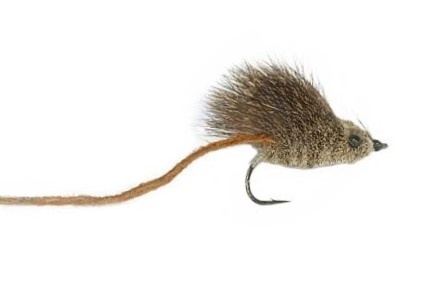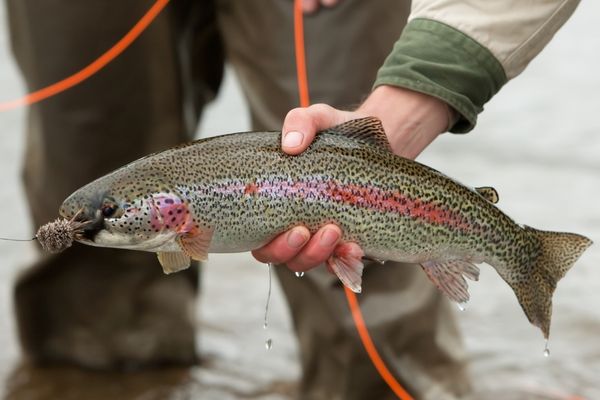Mouse flies are fun, and fishing them is fun. Watching a trout smash a large dry for the surface is exhilarating. This is why I do it.
But are mice flies really that effective of a pattern?
Time and time again, I read articles that suggest the secret to catching big trout at night is to skillfully work a mouse fly across their pool. The trophy size lurker, which lives in the depths will not be able to resist such a protein rich snack of red meat and will raise to the surface to smash it.
So, do mouse flies live up to their reputation? Are they the secret lure all night fishermen must carry, or is their reputation just hype?
In this article, I will discuss the mouse fly. When to use them, and when it is best to leave them at home.

When to fish a mouse fly?
The best time to fish a mouse fly is during a mouse plague.
A mouse plague is when the rodent population has increased to such extremes that they are everywhere. They scurry across the land in search of food, and due to the sheer number, many will eventually fall into the rivers and streams where the trout will take an interest in them.
The most common places mouse plagues occur seem to be in New Zealand every few years and in Alaska (shrews) over the summer months.
During a mouse plague, some trout really start to target them and such trout often grow to extreme sizes and trophy proportions. These large trout can eat many mice every day, I have seen a photo of one trout which had 9 mice in its belly.
The angler who caught it, also commented that the trout tasted bad. The digesting mice must have really tainted the flavor of the flesh.
Mice plagues are not common. They are in fact quite rare.
Fortunately, trout are not the most intelligent of fish and they will happily mistake a mouse fly for various different prey. To a hungry trout, a mouse fly could just as easily represent a swimming shrew, bird, frog, or even large terrestrial.
Are mouse flies effective at night?
Are mouse flies more effective at night, or are the trout just easier to catch because they are less wary?
I have caught plenty of trout on large surface flies, including mouse imitations during the day. It is very exciting fishing.
If the trout are feeding on mice, and have not been unduly pressured they are likely to show interest in taking a mouse fly at any time of day.
So are mouse flies more effective at night, or are the trout just less wary? Well, I think it is the latter. The trout are just feeling a bit more confident to hunt closer to the surface. But, given the right conditions a trout will just as happily slam a mouse imitation during the day as they will at night.
When night fishing, it also does not have to be a mouse fly. When the trout are feeding on large surface prey. Whether it be large insects, shrews, frogs, salamanders, ducklings or any other creature with a similar surface disturbing profile trout will likely show interest.
Trout, including big ones in the middle of the night, are most likely to take food that they are familiar with. Hence the saying to match the hatch. I have found a slightly smaller pattern typically brings better results because the trout confuse it for a wider range of food. Plus they are easier to cast.
I also want to note, that much of the time I doubt the trout are taking mice flies because they think it is a mouse. They are just responding to the surface responding and assume it is an easy meal. Any fly with similar dimensions will work.

Do only large trout take mice flies?
No, I have caught trout of all sizes on mice flies, and the majority of trout are typical of the fish you will usually catch in the river.
Fishing a mouse fly will not magically make larger fish appear. Now, there is some evidence to suggest that larger brown trout are more nocturnal. So they are more likely to be caught at night when people typically fish mice flies.
Also during a mice plague, trout can quickly put on condition. In only a few months a 5lb trout can easily be pushing 7 or 8lb. I also want to add, that fishing a mouse plague is not really worth the hype. Because so many anglers target such trout they usually become extremely wary and difficult to catch.
When I lived in New Zealand, I actually avoided the back countries’ fisheries during the mouse plague simply because they were seeing too much pressure and the quality of the fishing had started to deteriorate.
How to fish a mouse fly?
In this section, I will explain some of the basics behind fishing a mouse fly.
How to cast a mouse fly
Casting a mouse fly is just like casting any other large fly or streamer.
When fishing a mouse fly I typically use a 0x or 1x tippet. This thick tippet better transfers the power of the cast all the way to the fly making it easier to turn such a bulky fly over. Do not expect to easily turn them over with a microthin 5x tippet.
For similar reasons, and especially when night fishing I use a relatively short leader. I find it is easier to cast a heavy fly, like a mouse when using a shorter leader.
Mouse fishing is not about stealth or precision, the aim is to splash it out there and grab the trout’s attention. At night, the trout is not really going to see the flash of the fly line, so stealth is of minimal concern.
Unless for some reason you want to dead drift the mouse with the current, there is also no need to worry about drag or mending the line. Mouse flies are fished quite actively, so no need to maintain a natural drift.
How to retrieve a mouse fly?
This is an area with quite a bit of controversy. In my opinion, there is no right answer, but just keep experimenting and mixing things up while on the water.
Often, a slow, steady retrieve works best. Just gently and slowly work the mouse fly across the surface. The Figure of Eight retrieves works well to create a nice steady motion. The occasional pause also does not hurt.
Other times, I like to get a little more aggressive, and really cause a racket on the surface. A few aggressive strips can cause the fly to really smash through the water. This extra disturbance can grab the attention of feeding trout.
In general, I prefer to use the slow and steady retrieve when the trout are not aggressively feeding. When I can see the trout splashing about actively hunting is when I am more likely to fish more aggressively myself.
The other time I fish more aggressively is when there is more surface disturbance. The retrieve has to be louder to be heard over the disturbance caused by waves or fast flowing water.
Other helpful hints when mouse fishing?
Use a stripping basket when night fishing
When night fishing, I highly suggest using a stripping basket. It is hard to keep track of loose line and tangles in the dark, and in my experience fly line somehow always end up wrapping around rocks, boots, or getting stepped on. Save yourself many headaches and get a stripping basket when night fishing.
I usually make my own, out of a cheap plastic basket, thick cable ties to use as separators, and a belt. But it is nearly as cheap to buy a basic one from amazon. Stripping baskets really do work well and save a lot of headaches.
Consider wearing clear glasses at night
The purpose of wearing glasses at night might seem funny, but the prospect of getting a mouse fly in your eye is also not much fun. During the day, I recommend buying a pair of reasonable quality sunglasses, it does not matter much at night.
Just for added peace of mind, some clear plastic safety glasses are a good idea. Brand or exact model does not really matter and I just grab any laying around the workshop. If still after a recommendation Dewalt branded safety glasses can be brought for under $10 on amazon.
Practice during the day before fishing at night
Casting a fly rod in the dark is much tricker than during the day. The back cast is more likely to find trees, and if you are anything like me you will lose quite a bit of coordination and the fly will go off in all directions.
Before heading out for a night fish, it is always a good idea to practice with your kit during the day. Learn how it casts and behaves on the water.

